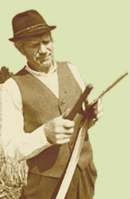Sealâs trace in the water
Mart Jüssi describes the newest results of the survey of the marked grey and ringed seals: seals move over long distances in the Baltic Sea. Using a modern technology â Fastloc GPS receiver that encompasses a little mobile phone and sends signals every time the seal hits the water rim â the scientists have managed to get some new knowledge about these water-based mammals. Based on the data derived from 6 grey seals and
3 ringed seals, the scientists concluded that grey seals make longer trips, while ringed seals move around on quite a small scale. Moreover, the Suur Väin Straits between the Muhumaa Island and the mainland is currently the only passage for ringed seals to get from their domestic grounds to feeding areas located in Livonian Bay. The planned bridge between Muhumaa and mainland would most likely cut off the last passage for this endangered marine mammal. The graphics derived from the data of the GPS receiver illustrate well the ways and habits of seal species in the Baltic Sea.
What is the influence of seals on fishing?
Markus Vetemaa looks at seals from the viewpoint of a fisherman: seals do not eat much seals, but impede fishing. No specific research regarding the menu of seals in Estonian waters has been done, but based on our neighboursâ research we can claim that the overall amount of fish eaten by seals is small compared to the fish caught by fishermen. The seals do, however, break drift nets and get killed in these as well. The author ends with a hot topic: should seal hunting be allowed in Estonia and concludes with a positive answer: if the Finns and Swedes are allowed to hunt grey seals in a limited amount, then why shouldnât the traditional huntsmen of Kihnu be able to catch their part of the game?
Seal fishing is an important feature of the identity of the Kihnu people
Mare Mätas explains the hunger of the Kihnu people for seal meat: it helps to retain the endangered folk culture. While Kihnu womenâs handicraft has been given recognition, then traditional male activities have been banned or limited. The men of the Kihnu Island have long and traditional knowledge of seals and their habits, and limited seal catch should be a natural part of the lifestyle of the Kihnu people.
Estonian nature enquires
Erik Puura writes about economical lamps versus LED-lamps.
Ivar Puura explains the creation of Estonian national database of biodiversity.
The immune response of an organism to the Influenza virus
Sirje Rüütel Boudinot explains the essence of the influenza virus, the way an organism is impaired and how human bodies develop immunological responses to the virus. The virus mostly impairs the epithelial cells covering the human respiratory tract as well as the immune cells of lungs, which are essential protective barriers of the human immune system. Therefore, the virus causes increased susceptibility to bacterial super infections.
Interview: The boundary between human and bestial will remain fuzzy
Toomas Kukk has interviewed Raivo Mänd, Professor of animal ecology.
The indicators for sustainability: software, which stimulates the user to analyze statistics
Kersti Salu and Kaia Oras suggest to âplayâ with free software, which is also helpful in finding connections between departments of knowledge. The Statistical Office of Estonia has recently launched electronic software for statistics regarding sustainable development. The table of indicators presents indicators for 4 fields of sustainable development: coherent society, growth of welfare, ecological balance and viability of cultural space. There are altogether 78 indicators, most of these encompassing the state level. Compared to other European countries, Estonia has shortcomings in energy production and consumption, but also lacks success when classical economical indicators are compared. The software also enables to use indexes and carry out connectivity analysis.
Practical tips: Photographing masters of flying
Sven ZaÄek shares the tips of nature photographers of how to shoot a picture of a flying bird â an object most difficult to shoot. He describes the types of flights and different flying mechanisms of different birds. As always, the text is supplemented with a number of illustrative photographs.
Tree of the year: The mysterious effect of hazelnut trees on the underbrush of a mixed spruce forest
Kadri Koorem convinces the reader of the differences between hazelnut trees and spruce trees: plants, too, can have friendly relationships with each other. Hazelnuts create favourable conditions for light-preferring as well as sciophytic herbaceous plants, its fast-decaying litter provides the undercover growth with nutrients and therefore increases the diversity of its underlying plant cover.
Tree of the year: On the etymology of âsarapuuâ (hazelnut tree)
Karl Pajusaluâs research on the etymology of the word âsarapuuâ â hazelnut tree. Instead of associating the word with âsarg: saraâ (enclosed field/garden), he relates it to the word âsaarâ (island). Most likely, the word has such an ancient origin that Estonian language in the current sense had not yet developed by then.
|


![[IN ENGLISH]](images/gb.gif)






